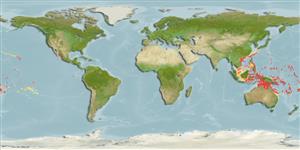>
Gobiiformes (Gobies) >
Gobiidae (Gobies) > Gobiinae
Etymology: Trimma: Greek, trimma, -atos = something crushed (Ref. 45335); benjamini: Named for Peter Benjamin, Toronto entrepreneur, Benjamin Films Ltd (Ref. 100726).
Eponymy: Peter Benjamin owns Benjamin Film Laboratory (Toronto), and is a keen amateur ichthyologist. He provided Winterbottom with free 35mm film and processing over two decades and has participated in several collecting expeditions. (Ref. 128868), visit book page.
More on author: Winterbottom.
Environment: milieu / Zona climática / intervalo de profundidade / distribution range
Ecologia
marinhas associadas(os) a recifes; intervalo de profundidade 1 - 90 m (Ref. 86942), usually 4 - 35 m (Ref. 90102). Tropical
Western Pacific: Sulawesi to Tonga; north to Marshall Islands; south to New Caledonia and the Great Barrier Reef.
Tamanho / Peso / Idade
Maturidade: Lm ? range ? - ? cm
Max length : 3.0 cm SL macho/indeterminado; (Ref. 48637); idade máx. registrada: 0.39 anos (Ref. 87294)
Descrição suscinta
Chaves de identificação | Morfologia | Morfometria
Espinhos dorsais (total) : 7; Raios dorsais (total) : 9 - 10; Espinhos anais: 1; Raios anais : 8 - 10. Distinguished by having the following characters: a deep concave, ‘U’-shaped interorbital trench; the bony interorbital about half pupil-diameter in width; with a slight groove posterodorsal to the eye; without median predorsal scales, sides of nape covered with small scales reaching to or near to the eyes; cheek and operculum without scales; base of pectoral-fin with oval, moderate-sized scales; prepelvic area with 5-6 rows of cycloid scales, isthmus naked anteriorly, with one slightly enlarged scale on the membrane between the bases of the pelvic fins; central 6-13 pectoral rays branched, uppermost and lowermost rays unbranched; fifth pelvic-fin ray branched once dichotomously and about 60-75% length of the fourth; all other rays usually with one sequential branch, basal membrane connecting the two pelvic fins only at the base; second dorsal spine longest, usually filamentous, extending at most to midway along the base of the second dorsal fin in Australian material; D2 usually I,10; A usually I, 9; nape crest fleshy from the first dorsal origin to above the operculum; when alive, head and body red, preserved yellow, the head with a thin vertical grey (bluish grey in life) bar from the anteroventral margin of the eye to the middle of the jaws and a second bar extending more-or-less vertically downward onto cheek from about the middle of the eye (often persisting in preserved material as faint grey bars); orbit rimmed with a thin band of melanophores, more distinct dorsally but faded in preserved material (Ref. 100726).
Cross section: oval.
Specimens were collected with rotenone (Ref. 13702). Inhabits coastal and outer reef slopes (Ref. 37816, 48637). Benthic, occuring singly or in loose groups, and a plankton-feeder; with prolonged pelagic larval duration of 33.9 days (= 24% of maximum lifespan) and linear post-larval growth; daily mortality rate ranging from 2.9% to 6.3%; sex ratio of 1:1.6 male/females) (Ref. 87294).
Ciclo de vida ou comportamento de acasalamento
Maturidade | Reprodução | Desova | Ovos | Fecundidade | Larvas
Winterbottom, R., 1996. A new species of gobiid fish, Trimma benjamini, from the western Pacific. Rev. Fr. Aquariol. 23(1-2):57-60. (Ref. 13702)
Status na Lista Vermelha da UICN (Ref. 130435: Version 2024-2)
Ameaça para os humanos
Harmless
Uso pelos humanos
Pescarias: sem interesse
Ferramentas
Relatórios especiais
Baixar XML
Fontes da internet
Estimates based on models
Preferred temperature (Ref.
123201): 25.4 - 28.9, mean 27.7 °C (based on 442 cells).
Índice de diversidade filogenética (Ref.
82804): PD
50 = 0.5000 [Uniqueness, from 0.5 = low to 2.0 = high].
Bayesian length-weight: a=0.01023 (0.00477 - 0.02194), b=3.01 (2.83 - 3.19), in cm total length, based on LWR estimates for this (Sub)family-body shape (Ref.
93245).
Generation time: 0.1 ( na - na) years. Estimated as median ln(3)/K based on 1
growth studies.
Resiliência (Ref.
120179): Elevada, tempo mínimo de duplicação da população menor que 15 meses (Preliminary K or Fecundity.).
Fishing Vulnerability (Ref.
59153): Low vulnerability (10 of 100).
🛈
Nutrients (Ref.
124155): Calcium = 660 [148, 8,086] mg/100g; Iron = 5.4 [1.0, 21.6] mg/100g; Protein = 17.9 [14.6, 20.9] %; Omega3 = 0.145 [0.011, 1.898] g/100g; Selenium = 211 [14, 2,380] μg/100g; VitaminA = 10.7 [0.3, 289.8] μg/100g; Zinc = 12.2 [3.3, 33.4] mg/100g (wet weight);
